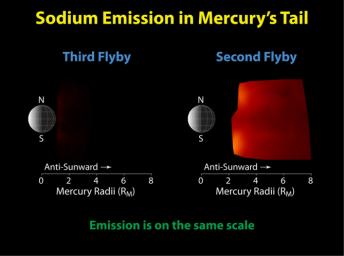
|
Mercury Flyby 3 Reveals a Highly Diminished Sodium Tail
- Click the image above for a larger view
- Full-Res JPEG (1020 x 759) (54.8 kB)
- Full-Res TIFF (1020 x 759) (2.3 MB)
Caption:
These figures show comparisons of the neutral sodium observed during MESSENGER's second and third Mercury flybys. The left panel shows that emission from neutral sodium in Mercury's tail, which extends away from the planet in the anti-sunward direction, was a factor of 10-20 less than during the second flyby, shown in the right panel. This difference is due to variations in the pressure that solar radiation exerts on the sodium as Mercury moves in its orbit. During the third flyby, the net effect of radiation pressure was small, and the sodium atoms released from Mercury's surface were not accelerated anti-sunward as they were during the first two flybys , resulting in a diminished sodium tail. These predictable changes lead to what are effectively "seasonal" effects on the distribution of exospheric species. Observations of the sodium exosphere and tail throughout Mercury's orbit during MESSENGER's orbital mission phase will enable such "seasonal" effects to be studied.
Date Acquired:
October 6, 2008, and September 29, 2009
Instrument:
Mercury Atmospheric and Surface Composition Spectrometer (MASCS)
Background Info:
These images are from MESSENGER, a NASA Discovery mission to conduct the first orbital study of the innermost planet, Mercury. For information regarding the use of images, see the MESSENGER image use policy .
Cataloging Keywords:
| Name | Value | Additional Values |
|---|---|---|
| Target | Mercury | |
| System | ||
| Target Type | Planet | |
| Mission | MESSENGER | |
| Instrument Host | MESSENGER | |
| Host Type | Orbiter | |
| Instrument | Mercury Atmospheric and Surface Composition Spectrometer (MASCS) | |
| Detector | ||
| Extra Keywords | Atmosphere, Color | |
| Acquisition Date | ||
| Release Date | 2009-11-03 | |
| Date in Caption | 2008-10-06 | 2009-09-29 |
| Image Credit | NASA/Johns Hopkins University Applied Physics Laboratory/Carnegie Institution of Washington | |
| Source | photojournal.jpl.nasa.gov/catalog/PIA12364 | |
| Identifier | PIA12364 | |
